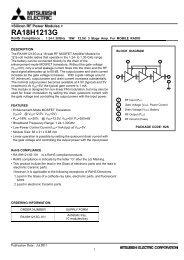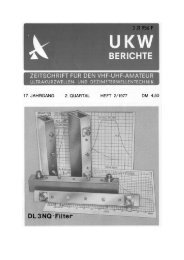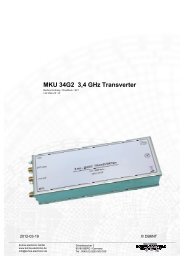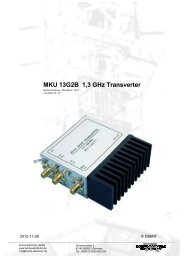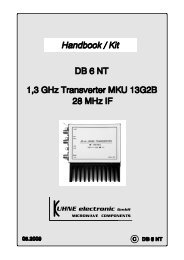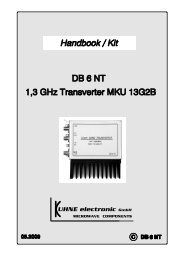2,3 GHz Transverter MKU23G2 - Kuhne electronic
2,3 GHz Transverter MKU23G2 - Kuhne electronic
2,3 GHz Transverter MKU23G2 - Kuhne electronic
Sie wollen auch ein ePaper? Erhöhen Sie die Reichweite Ihrer Titel.
YUMPU macht aus Druck-PDFs automatisch weboptimierte ePaper, die Google liebt.
Schaltungsbeschreibung:<br />
<strong>Kuhne</strong> <strong>electronic</strong> GmbH<br />
www.kuhne-<strong>electronic</strong>.de<br />
info@kuhne-<strong>electronic</strong>.de<br />
2,3 <strong>GHz</strong> <strong>Transverter</strong> <strong>MKU23G2</strong><br />
Der bewährte „Simple Quarzoszillator“ mit dem FET SST310<br />
schwingt auf 120,889 MHz. Die Frequenzeinstellung erfolgt<br />
durch den Messingkern in der Oszillatorspule. Ein auf das 40<br />
°C Quarz aufgesteckter Heizer stabilisiert die Quarztemperatur<br />
und hält somit die Frequenzdrift in Grenzen. Durch Einbau<br />
entsprechender Kondensatoren (TK. Im Schaltplan mit *<br />
gekennzeichnet) wird im Oszillator eine Temperatur-<br />
Kompensation erreicht. Dafür sind 2 Lötstellen vorgesehen.<br />
Die Stabilität reicht für normale Verhältnisse aus.<br />
Sollte eine sehr genaue und hochstabile Frequenz benötigt<br />
werden, ist an der im Schaltplan eingezeichneten Stelle ein<br />
externer „Ofenstabilisierter“ Oszillator „OCXO“ mit ca. 1 mW<br />
(DF9LN) ein zu koppeln. Dazu wird der Quarz entfernt.<br />
Nach dem Oszillator folgt eine Verdreifacher-Stufe mit dem<br />
BFR92. Über ein Helixfilter wird die Frequenz 362 MHz<br />
selektiert und auf den Verdreifacher mit BFG 93A gekoppelt.<br />
Nach einem weiteren Helixfilter, das auf 1088 MHz abgestimmt<br />
wird, gelangt das Signal auf einen Frequenzverdoppler. Nach<br />
dem Helixfilter auf der LO- Endfrequenz 2176 MHz steht eine<br />
LO-Leistung von ca. 5 mW zu Verfügung.<br />
Das ZF-Signal wird über getrennt einstellbare<br />
Dämpfungsglieder für Sender und Empfänger geführt, die<br />
durch PIN-Dioden umgeschaltet werden.<br />
Die Sende-Empfangs-Umschaltung des gesamten<br />
<strong>Transverter</strong>s erfolgt über eine Plusspannung bei TX auf dem<br />
ZF-Steuerkabel, wie es bei dem FT290R bereits eingebaut ist.<br />
Bei anderen Transceivern ist ein kleiner Umbau erforderlich<br />
(Eine bei Senden verwendete +Spannung im 2 m Transceiver,<br />
über einen 2K2 Widerstand auf die Ausgangsbuchse legen.<br />
Fertig!). Diese Steuerung benötigt keine weiteren Steuerkabel<br />
und hat sich seit Jahren bestens bewährt. Des weiteren ist<br />
aber auch die klassische Umschaltung mit PTT-Kontakt nach<br />
Masse möglich.<br />
Die Betriebsspannungsumschaltung im <strong>Transverter</strong> erfolgt<br />
durch Transistoren. Die Schaltspannung des Senders ist<br />
herausgeführt und kann zur Steuerung von Koaxrelais sowie<br />
PA-Verstärkern verwendet werden (max. 2 A belastbar). Dieser<br />
Ausgang sollte unbedingt mit einer Feinsicherung geschützt<br />
werden.<br />
Das Empfangsteil besitzt eine HEMT-FET Vorstufe und einen<br />
weiteren MMIC mit einer Gesamtverstärkung von > 30 dB.<br />
Dadurch wird kein weiterer ZF-Verstärker benötigt.<br />
Das über einen 4,7 pF Kondensator gekoppelte<br />
Eingangssignal wird dem rauschangepassten NE32584C<br />
zugeführt. Danach folgt über ein Multilayer-Keramikfilter F6 die<br />
zweite Stufe mit dem MMIC - MGA86563. Über die RX-TX<br />
PIN-Diodenumschaltung und ein weiteres Helixfilter F4 folgt<br />
der Ringmischer.<br />
Über das auch für den Sendezweig benützte Helixfilter F4<br />
hinter dem Mischer, gelangt im Sendefall das TX-Signal auf<br />
eine MMIC Verstärkerstufe. Über ein weiteres Helixfilter F5 zur<br />
Nebenwellenunterdrückung wird das zweite MMIC ERA 5-SM<br />
angesteuert. Die darauf folgende Endstufe ist mit dem GaAs<br />
Power FET MGF 0904 bestückt.<br />
Zur Nebenwellenunterdrückung werden Helixfilter verwendet.<br />
Am Senderausgang ist ein Richtkoppler mit Schottkydiode<br />
BAT62-03W eingebaut. Er ermöglicht die Kontrolle der<br />
Ausgangsleistung (Monitor = MON.) und erleichtert den<br />
Abgleich der Schaltung.<br />
Description:<br />
Scheibenacker 3<br />
95180 BERG / Germany<br />
Tel.: 0049 (0) 9293 800 939<br />
2012-03-19<br />
The well proven “Simple Quartz Oscillator” with its FET<br />
SST310 operates at 120.889 MHz. Frequency tuning is<br />
achieved by the brass slug in the oscillator coil. A heater which<br />
is mounted on a 40 °C thermostat crystal stabilizes the crystal<br />
temperature and keeps the frequency drift in limits. Application<br />
of relevant capacitors (TK. Marked with * in the schematic) will<br />
result a temperature compensation. Two capacitor soldering<br />
points have been provided for this feature. Stability should be<br />
sufficient for average working conditions. Should there be the<br />
need for an exact and highly stable frequency, an ovencontrolled<br />
oscillator (DF9LN) with an output of approx. 1 mW<br />
may be connected to the circuitry at the marked location. For<br />
this change the original crystal must be removed.<br />
Following the oscillator is a tripler with a BFR92. A frequency of<br />
362 MHz is being selected by a helix filter and then is being<br />
coupled into a tripler with a BFG93A. After an additional helix<br />
filter, which is to be tuned to 1088 MHz, the signal is being<br />
passed to a frequency doubler. After a helix filter with a final<br />
local oscillator (LO) frequency of 2176 MHz a LO-power of 5<br />
mW is available.<br />
The IF signal is being passed through individually tunable<br />
attenuator pads for transmitter and receiver; switching occurs<br />
by PIN-diodes.<br />
Transmit/receive switching of the entire transverter is being<br />
controlled by a positive voltage during TX of the IF control<br />
cable; e.g. such a voltage is available at the output of the<br />
FT290R. Other transceivers need a small modification: connect<br />
a positive voltage, that is being generated within the transceiver<br />
during transmit mode, to the output connector via a 2K2<br />
resistor. That’s all! This type of control needs no additional<br />
control cables and has been well proven over the years.<br />
Naturally it is also possible to achieve conventional switchover<br />
with a PTT contact to ground.<br />
Switching of operating voltages within the transverter is being<br />
controlled by transistors. Switching voltage of the transmitter is<br />
being externally provided and may be used for the control of<br />
coax-relays or final amplifiers (max. load 2 A). This output<br />
must be protected by a fine-wire fuse under all circumstances.<br />
The receiving section has a preamplifier stage with a HEMT-<br />
FET and an additional MMIC with a total amplification of > 30<br />
dB. This eliminates the need for an additional IF-amplifier.<br />
The input signal is being coupled to a noise-adapted<br />
NE32584C via a 4.7 pF capacitor.<br />
The second stage with the MMIC - MGA86563 follows via the<br />
multi-layer ceramic filter F6. A RX-TX PIN diode switch is being<br />
followed by another helix filter F4 and the ring mixer.<br />
During transmit the TX-signal is being passed to a MMIC<br />
amplifier stage via the helix filter F4 following the mixer. The<br />
signal reaches a second MMIC ERA 5-SM after passing an<br />
additional helix filter F5 used for suppression of spurious<br />
emissions. The following final stage is equipped with a GaAs<br />
power FET MGF 0904.<br />
The transmitter output has a directional coupler with the<br />
Schottky-diode BAT62-03W. It facilitates monitoring of the<br />
output power (monitoring MON.) and supports the alignment of<br />
the circuitry.



